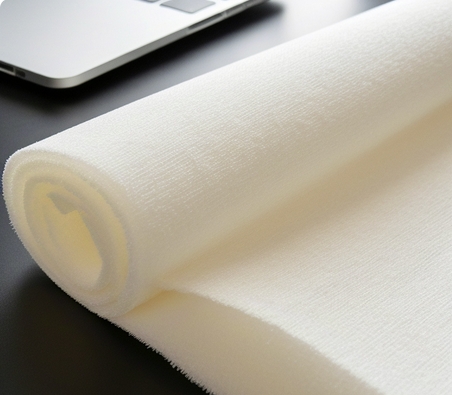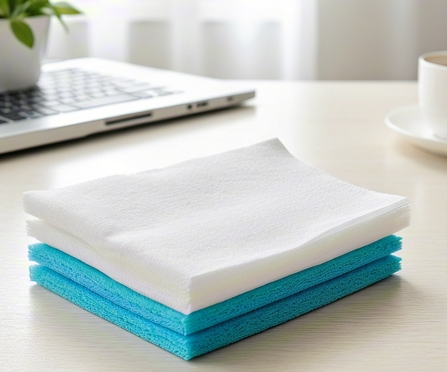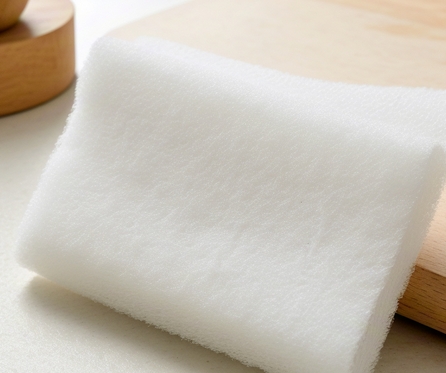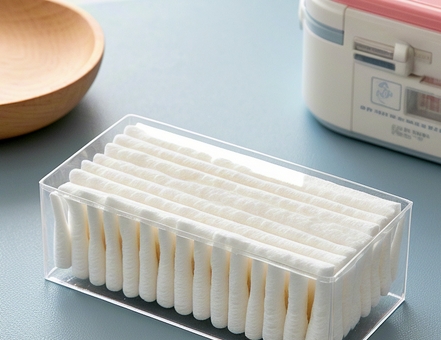Language

In highly sensitive clean rooms and controlled environments, dust-free wipes are a dual mission as key consumables – ensuring that the working surface meets microbial control standards and effectively deal with accidental spill accidents. This type of wipe cloth is mainly divided into two categories according to the substrate structure: knitted wipe cloth and nonwoven wipe cloth. The difference in performance directly affects the selection decisions of different industrial scenarios.
From the perspective of material engineering, high-quality dust-free wipes need to meet three core indicators: fiber shedding is less than 0.1 mg/m² (according to the IEST-RP-CC004.3 test standard), non-volatile residues (NVRs) less than 10 μg/cm², and ion pollution levels are controlled below 0.3 μg/cm². Taking the semiconductor manufacturing workshop as an example, staff prefer to use a knitted wipe cloth with 100% continuous polyester fiber. Its unique warp and weft knitted structure is like a precision filter, which can not only effectively capture 0.5 micron particles, but also has the durability characteristics of resistant to 120 autoclave cycles.
Nonwoven wipes have outstanding cost-effectiveness, and the three-dimensional fiber network formed by its hydros puncture process can achieve a liquid absorption of 200%. Medical packaging companies often choose nonwoven products made of polypropylene. When used with quaternary ammonium salt disinfectant, the surface tension can be reduced to below 30dyn/cm to ensure complete wetting. However, it should be noted that when such materials are exposed to organic solvents such as isopropanol, they may experience a dimensional shrinkage of 5-8%.
In contrast, knitted wipes have significant advantages in cleanliness. A 9"x9" specification product using laser edge sealing technology has been released through dynamic particle release tests, and only 12 particles ≥0.3μm per minute per square foot. Biopharmaceutical companies mostly choose polyester/nylon blended knitted models on the filling line. Their electrostatic dissipation characteristics can stabilize the surface resistance in the range of 10^6-10^9Ω, perfectly comply with the requirements of camp specifications.
When making procurement decisions, comprehensive evaluation of usage scenarios is required: it is recommended to use an anti-statically treated 12"x12" knitted wipe cloth, which has a unique honeycomb fiber arrangement to avoid friction charges of >0.1pC. For conventional laboratory cleaning, 6"x6" spun lace nonwoven fabric can be selected. This product that uses hydraulic entanglement technology can still withstand the mechanical strength test of 5kg/cm² while maintaining a low weight of 2.3g/m².
In the field of industrial-grade cleaning consumables, multiple professional series have achieved standardized size upgrades. Taking precision electronic manufacturing scenarios as an example, the industry-leading x6 (4-inch x 6-inch) and x10 (8-inch x 10-inch) rectangular specifications have now become the preferred configuration for semiconductor workshops and optical laboratories. This golden ratio rectangular design not only adapts to the clamping system of automatic cleaning equipment, but also reduces material folding losses during cleaning.
In the internationally certified dust-free wipes series, the single cleaning area of x6-sized products that meet ISO 14644-1 standards can reach 16 square inches, especially suitable for surface maintenance of wafer vehicles.
The x10-specification product made by electro spinning process has been shown to be 40% higher than conventional products by testing by ASTM F2100, and it has demonstrated excellent particle capture capabilities in the field of medical equipment cleaning.
Tags:
RELATED RESOURCES

7 Questions on Selecting Ultrafine Dust-Free Wipes: Comparative Analysis of Ultrafine Fiber Cleaning
Comparative analysis of ultra-fine dust-free cloth and ultra-fine dust-free cloth: professional selection guid......
More

Dust-free wipe cleaning technology essential: key parameters to improve 300-hour maintenance cycle
In the advanced manufacturing quality control system, dust-free wipe cloth cleaning technology has developed i......
More

9.9Inch dust-free wipe size specification: How ISO standards reduce consumable costs by 30%
Clean room cleaning revolution: Decrypting the scientific design of 9x9-inch dust-free wipesHistorical evoluti......
More

How to Choose Compliant Swabs?TOC Testing + Sterilization Standards to Improve Clean Sampling Pass R
In the field of pharmaceutical and biotechnology, the cleanliness control of equipment and production environm......
More
Related Products
Room 101, Building 1, Angeer Factory, No.4, Hetian Road, Shatian Community, Kengzi Street, Pingshan District, Shenzhen, Guangdong, P.R. China 518122
info@wipestar.com
+86-755-89616775
+86-755-89616773
Related Products
RELATED RESOURCES

7 Questions on Selecting Ultrafine Dust-Free Wipes: Comparative Analysis of Ultrafine Fiber Cleaning
Comparative analysis of ultra-fine dust-free cloth and ultra-fine dust-free cloth: professional selection guid.........
More

Dust-free wipe cleaning technology essential: key parameters to improve 300-hour maintenance cycle
In the advanced manufacturing quality control system, dust-free wipe cloth cleaning technology has developed i.........
More
WIPESTAR
微信官方公众号